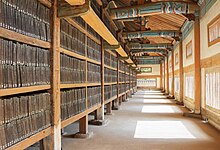
Back تربتاكا كوريانا Arabic Tripitaka Koreana BCL Tripitaka Coreana Catalan Tripitaka Koreana German Tripitaka Koreana Esperanto Tripitaka Coreana Spanish تریپیتاکا کوریانا Persian Tripitaka Koreana French त्रिपिटक कोरिया Hindi Tripitaka Koreana Hungarian
| UNESCO World Heritage Site | |
|---|---|
 The Tripiṭaka Koreana in storage at Haeinsa (2022) | |
| Location | South Korea |
| Criteria | Cultural: iv, vi |
| Reference | 737 |
| Inscription | 1995 (19th Session) |
| Coordinates | 35°48′N 128°06′E / 35.800°N 128.100°E |
| Tripitaka Koreana | |
| Hangul | 팔만 대장경 or 고려 대장경 |
|---|---|
| Hanja | |
| Revised Romanization | Palman Daejanggyeong or Goryeo Daejanggyeong |
| McCune–Reischauer | P'alman Taejanggyŏng or Koryŏ Taejanggyŏng |
The Tripiṭaka Koreana[a] is a Korean collection of the Tripiṭaka (Buddhist scriptures), carved onto 81,258 wooden printing blocks in the 13th century. They are currently located at the Buddhist temple Haeinsa, in South Gyeongsang Province, South Korea.[1]
It is the oldest intact version of Buddhist canon in Hanja script. It contains 1,496 titles, divided into 6,568 books, spanning 81,258 pages, for a total 52,330,152 Hanja characters.[2] The Tripiṭaka was designated a National Treasure of South Korea in 1962, and inscribed in the UNESCO Memory of the World Register in 2007.[3][1]
Each wood block (page) measures 24 centimetres in height and 70 centimetres (9.4 in × 27.6 in) in length.[4] The thickness of the blocks ranges from 2.6 to 4 centimetres (1.0–1.6 in) and each weighs about three to four kilograms (6.61 - 8.81 lbs). The woodblocks would be almost as tall as Paektu Mountain at 2.74 km (1.70 mi) if stacked and would measure 60 km (37 mi) long if lined up, and weigh 280 tons in total.[5] The woodblocks are in pristine condition without warping or deformation despite being created more than 750 years ago.[6][7]
Haeinsa has decided to open the Palman Daejanggyeong, which was limited to Buddhist events, to pre-booked members of the public every weekend, morning and afternoon from 19 June 2021.[8]
Cite error: There are <ref group=lower-alpha> tags or {{efn}} templates on this page, but the references will not show without a {{reflist|group=lower-alpha}} template or {{notelist}} template (see the help page).
- ^ a b "Printing woodblocks of the Tripiṭaka Koreana and miscellaneous Buddhist scriptures". UNESCO Memory of the World. United Nations. Retrieved 30 July 2016.
- ^ "Wooden block printing perfection of Tripitaka Koreana". The Korea Herald. 13 November 2021.
- ^ "Printing Woodblocks of the Tripitaka Koreana in Haeinsa Temple, Hapcheon". Cultural Heritage Administration. Korea Tourism Organization. Retrieved 1 October 2016.
- ^ "Haeinsa Temple Janggyeong Panjeon, the Depositories for the Tripitaka Koreana Woodblocks" (PDF). UNESCO World Heritage Centre. United Nations. Retrieved 30 July 2016.
- ^ Park, Sang-jin (18 September 2014). Under the Microscope: The Secrets of the Tripitaka Koreana Woodblocks. Cambridge Scholars Publishing. p. 6. ISBN 9781443867320. Retrieved 30 September 2016.
- ^ World Heritage in Korea. Cultural Heritage Administration (South Korea). 19 November 2011. p. 188. ISBN 9788981241773. Retrieved 30 July 2016.
- ^ Park, Sang-jin (18 September 2014). Under the Microscope: The Secrets of the Tripitaka Koreana Woodblocks. Cambridge Scholars Publishing. p. 131. ISBN 9781443867320. Retrieved 30 July 2016.
- ^ Ki, Jung-hoon (12 June 2021). "World Heritage Tripitaka Koreana, also visible to the public". YTN (in Korean). Retrieved 12 June 2021.
© MMXXIII Rich X Search. We shall prevail. All rights reserved. Rich X Search
